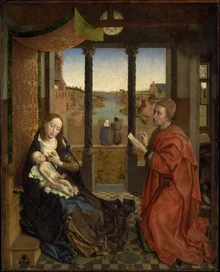Saint Luke Drawing The Virgin

Brief Identification
Saint Luke Drawing the Virgin was painted around 1435-1440 by Rogier van der Weyden. Van Der Weyden, was born in the Belgium in 1400. Saint Luke Drawing the Virgin is a painting from the early Renaissance period, a work of iconography. In Byzantine theology, the popular notion you could communicate directly with saints through the icons that they were represented in. Saint Luke Drawing the Virgin is based on 6th century folklore that Saint Luke was the first to paint a picture the Virgin Mary.
Technical Evaluation
Tempera paintings are a medium of paintings that stretch back to the ancient Egyptian, Babylonian, and Chinese cultures. Tempera was often made with the yolks of fresh eggs, the egg whites, or sometimes the whole egg, along with linseed oil; to develop a durable, and quickly drying paint. The painting is supposed to have been housed in the cathedral of St. Gudula and eventually ending up in the hands of the grandnephew of King Carlos III of Spain. Mr. and Mrs. Henry Lee Higginson buy it at an auction and eventually gift it to the Museum of Fine Arts in Boston, MA.
Local Historical Context
Saint Luke Drawing the Virgin was commissioned for the Guild of Saint Luke in Brussels, Belgium around 1435-1440. This painting part of the iconoclastic Christian culture in the Renaissance Period. Most people in Europe at this time were part of the serf class. Rogier van der Weyden, however, was the son of a master cutler and was a part of the merchant class. Rogier van der Weyden's painting is ripe with biblical imagery, and Christian mythology. Biblical imagery that can be found within the painting are the figures of Adam and Eve, along with the serpent on the throne; Christ and Mary represent the redemption for the world.
World-Historical Significance
Saint Luke Drawing the Virgin is one of many examples Renaissance paintings in which Christian theology and mythology are combined. The uniqueness of the Christian theology is that it is rooted in Jewish theology and is displayed in this painting, as it is throughout the gospels. What is the most significant about Saint Luke Drawing the Virgin is that it extrapolates from the Biblical theology into Christian mythology, through the deification of Mary and the legend of Saint Luke being the first to paint her.
Bibliography
Ishikawa, Chiyo. "Rogier Van Der Weyden's "Saint Luke Drawing the Virgin" Reexamined." Journal of the Museum of Fine Arts, Boston 2 (1990): 49-64. http://www.jstor.org.proxy-remote.galib.uga.edu/stable/20519725.
White, Eric Marshall. Rogier Van Der Weyden: St. Luke Drawing the Virgin: Selected Essays in Context. Turnhout: Brepols, 1997.
https://www.mfa.org/collections/object/saint-luke-drawing-the-virgin-31035
https://www.hermitagemuseum.org/wps/portal/hermitage/digital-collection/01.+Paintings/38861/
https://www.britannica.com/biography/Rogier-van-der-Weyden
https://www.britannica.com/art/tempera-painting
Saint Luke Drawing The Virgin
Source: https://history2701.fandom.com/wiki/Saint_Luke_Drawing_the_Virgin
Posted by: painterfropriat.blogspot.com

0 Response to "Saint Luke Drawing The Virgin"
Post a Comment